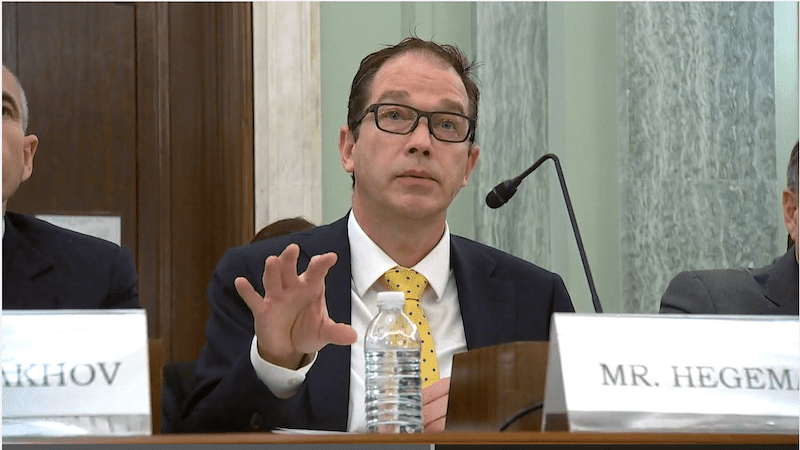On the Congressional Record: GE Aerospace Testifies About Game-Changing Next-Gen Technology Development
March 30, 2023 | by Chelsey Levingston
“There has never been a more exciting time in my 25-year career as an aerospace engineer,” said GE Aerospace General Manager of Advanced Technologies Arjan Hegeman yesterday in remarks before the Senate Committee on Commerce, Science and Transportation. The hearing, on “Advancing Next Generation Aviation Technologies,” was part of the Senate’s work on the 2023 FAA Reauthorization Act. “This era of innovation requires ongoing collaboration with federal agencies like NASA and the FAA,” Hegeman said. (View the full session here.)
Currently GE Aerospace is carrying out one of the company’s most extensive technology development roadmaps in its more than 100-year history. Multiple ground and flight tests planned this decade will seek new breakthrough technologies for use in next-generation commercial aircraft engines that could enter service beginning in the mid-2030s.
 Arjan Hegeman. Top: In 2022, GE completed successful ground testing of its Passport long-range business aviation engine using 100% sustainable aviation fuel. Credit: GE Aerospace. Videos credit: GE Aerospace
Arjan Hegeman. Top: In 2022, GE completed successful ground testing of its Passport long-range business aviation engine using 100% sustainable aviation fuel. Credit: GE Aerospace. Videos credit: GE Aerospace
Advanced engine architectures such as open fan, hybrid electric propulsion systems, and new compact engine core designs — just some of the technologies that will be demonstrated on test stands, ground tests, and flight tests over the coming years — are all key programs to watch.
In addition to maturing these technologies for flight readiness and new products, GE Aerospace also supports efforts to increase use and availability of alternative fuels, such as sustainable aviation fuel (SAF) and hydrogen.
Revolutionary technologies and alternative fuels both have critical roles to play in meeting the aviation industry’s long-term climate goal of net-zero carbon emissions by 2050 for commercial flight.
Here, we’ve laid out GE’s top innovations and industry-leading efforts to watch in the march toward net zero.
Open Fan and the CFM RISE Program
Hegeman and other GE Aerospace engineering leaders believe the time for open fan is now. Why? Since GE first flew an unducted fan in the 1980s, the open-fan engine design has been made simpler and lighter with new approaches such as single-stage rotating carbon-fiber composite fan blades and stationary outlet guide vanes. Learn more here.
The open-fan design is one of the advanced engine architectures CFM International, a 50-50 joint company between GE and Safran Aircraft Engines, is exploring through the CFM RISE Program. The parent companies came together in June 2021 to unveil the RISE Program with a target of more than 20% better fuel consumption and lower CO2 emissions than in today’s most efficient engines. Technologies matured as part of the RISE Program will serve as the foundation for the next-generation CFM engine that could be available by the mid-2030s. Central to the program is state-of-the-art propulsive efficiency.
A More Electric Future of Flight
Even before NASA announced in September 2021 the selection of GE Aerospace for its Electrified Powertrain Flight Demonstration (EPFD) program, GE had been advancing electrification of aircraft and engine systems for more than a decade. During that time, GE engineers matured individual components of a hybrid electric system, including motors, generators, and power converters.
Now the jet engine maker and aircraft systems company will take what it’s learned in laboratories about making an integrated electric machine and ready it for ground and flight tests planned for the mid-2020s.
Through the total $260 million program with NASA, GE Aerospace is maturing a megawatt-class hybrid electric powertrain to demonstrate flight readiness for single-aisle aircraft using a modified Saab 340B test bed and GE’s CT7 turboprop engines. GE is partnering with Boeing, which will support the program’s flight tests, and has selected BAE Systems to design, test, and supply energy management components.
Smaller Core, Greater Efficiency
One of the enabling technologies being studied in CFM’s RISE Program is a compact engine core. In another multimillion-dollar program with NASA announced in late 2021, GE Aerospace was awarded contracts to test and mature new jet engine core designs, including compressor, combustor, and high-pressure turbine technologies to improve thermal efficiency. Continued development of ceramic matrix composites, an advanced, heat-resistant material, is also a key part of the effort to improve fuel efficiency and thereby reduce emissions. GE Aerospace expects this effort to lead to a ground test later this decade.
Powering Multiple Firsts for Sustainable Aviation Fuel (SAF)
For more than a decade, GE Aerospace has supported multiple flight demonstrations with SAF. This work includes the industry’s first commercial demonstration flight of biofuel, in 2008, using a Virgin Atlantic Boeing 747 powered by GE’s CF6 engines; the first commercial airliner flight with 100% SAF in both engines, on the 2018 Boeing ecoDemonstrator, a FedEx Express Boeing 777 powered by GE90 engines; the first passenger experimental flight with 100% SAF in one of the two engines, in 2021, using a United Airlines Boeing 737 MAX 8 powered by CFM LEAP engines,* and the first demonstration flight in the Middle East using 100% SAF in one of the two engines.
All GE Aerospace and CFM International engines can operate on approved SAF blends today, which can be made from plant-based material, fats, oils and greases, alcohols, waste streams, captured CO2, and other alternative feedstocks. SAF has the same chemical composition as the jet fuel most commonly used today. The key difference is that instead of being made from fossil-based sources, SAF is made from more renewable sources. The use of alternative feedstocks and processes reduces life-cycle CO2 emissions during production, processing, and distribution compared with fossil-based fuels.
Additionally, all SAF approved today is drop-in, able to replace conventional jet fuel, requiring no changes to aircraft equipment or fueling infrastructure to use it.
“We have very clear goals, and very ambitious ones,” said Zeina Chakhtoura, senior customer support manager for GE Aerospace. “We are industry leaders when it comes to pushing for SAF and decarbonization in general, by leveraging existing technology and inventing the future of flight.”
Pioneering Hydrogen Combustion
The announcement made in February 2022 that CFM and Airbus are collaborating on a hydrogen demonstration program will be informed in part by GE’s experience with hydrogen fuels in land-based gas power turbines. GE has more than 8 million operating hours of experience with hydrogen fuel blends, including with aeroderivative engines.
With plans to flight-test a hydrogen combustion engine around the middle of this decade, CFM’s RISE and Airbus’s ZEROe programs come together.
CFM will modify the combustor, fuel system, and control system of a GE Passport turbofan to run on hydrogen. The engine was selected because of its physical size, advanced turbo machinery, and fuel flow capability. It will be mounted along the rear fuselage of the flying test bed to allow engine emissions, including contrails, to be monitored separately from those of the engines powering the aircraft. CFM will execute an extensive ground test program ahead of the A380 flight test.
“We will fly a modified engine to learn the art of the possible and to prove out the technologies,” said Mohamed Ali, vice president and general manager of engineering for GE Aerospace. “Is hydrogen harder? Yes. Is it doable? Absolutely. And we are building on tremendous experience, and I am actually very encouraged by the inventions we have already made to address those challenges.”
* LEAP engines are a product of CFM International, a 50-50 joint company between GE and Safran Aircraft Engines.





